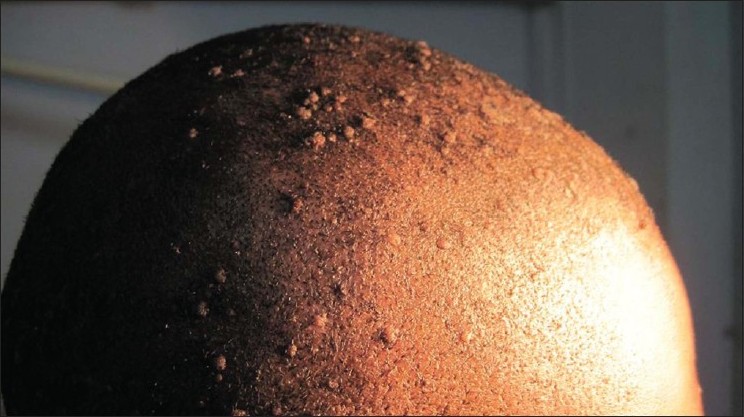Translate this page into:
Rapid response to acitretin, combined with cryotherapy, for extensive and recalcitrant verruca vulgaris on the scalp
Correspondence Address:
Feroze Kaliyadan
Department of Dermatology, Amrita Institute of Medical Sciences and Research Centre, Elamakkara, Kochi - 682 026, Kerala
India
| How to cite this article: Kaliyadan F, Dharmaratnam A D. Rapid response to acitretin, combined with cryotherapy, for extensive and recalcitrant verruca vulgaris on the scalp. Indian J Dermatol Venereol Leprol 2011;77:338-340 |
Sir,
It is often difficult to treat patients presenting with extensive verruca vulgaris on areas like the scalp and the beard area. Traditional methods like topical keratolytics, cryotherapy and electrocautery/radiofrequency ablation require long treatment duration, multiple sittings, and are often associated with recurrences. We report a case of a 22-year-old male patient presenting with extensive scalp warts refractory to conventional treatment who had an excellent response to treatment with acitretin.
A 22-year-old male patient, a native of Burundi (in Africa), presented to our out-patient department with a history of multiple warts over his scalp since the previous 2 years. The patient had tried various treatment modalities for the same with minimal success. The treatment modalities used included cryotherapy, topical podophyllin, salicylic acid, and radiofrequency. In spite of multiple sittings, complete clearance was never achieved and prompt recurrences over the treated areas were seen. The patient did not have a history of any other significant skin or systemic disease. There was no significant drug or family history. On examination, multiple warts were seen covering the entire scalp [Figure - 1]. Scars were seen in some previously treated areas. Isolated warts were seen on the dorsum of the hands.
 |
| Figure 1: Extensive warts over the scalp - Day 1 |
The patient was investigated to rule out any associated systemic disease. All routine investigations were within normal limits. HIV and hepatitis B/C serology were negative.
The patient was started on a systemic retinoid (acitretin 0.5 mg/kg once daily) after appropriate laboratory work-up for the same (including fasting lipid profile and liver function tests). This was combined with once weekly cryotherapy (with liquid nitrogen spray). At the end of 4 weeks, there was dramatic and complete clearance of the lesions with no recurrence [Figure - 2] and [Figure - 3]. The patient had to return to his native country after 1 month. He was asked to continue on acitretin alone for a period of two more months, with monthly monitoring of the lipid profile and liver function tests. Except for minimal skin dryness, the patient did not have any other significant adverse effects secondary to acitretin. Regular follow-up was done through e-mail. At the end of 3 months, retinoids were stopped. The patient has now been on follow-up for 5 months and there has been no recurrence of the lesions.
 |
| Figure 2: After 2 weeks of treatment with cryotherapy and systemic retinoids |
 |
| Figure 3: After 4 weeks of treatment with cryotherapy and systemic retinoids |
Viral warts tend to disappear even without treatment over a period of around 2 years. A small percentage of viral warts however tend to be recalcitrant - either showing no response to treatment or having prompt recurrences after treatment. This can often be seen even in normal healthy patients especially when the beard or scalp area is affected. [1],[2] Systemic retinoids have been advocated as a useful treatment modality for recalcitrant warts. Retinoids have an effect on cutaneous immunomodulation as well as epithelial cell proliferation and differentiation. As HPV replication is related to the state of keratinocyte differentiation, it is possible that acitretin may inhibit the replication and assembly of HPV within the affected cells. [3] There are many reports of acitretin being effective in recalcitrant warts in both immunocompetent [2],[4] and immunosuppressed patients. [5],[6]
In our case too, acitretin produced a complete clearance of the warts. However, retinoids generally take at least 2 months to produce total control of the lesions. Hence we feel that while acitretin alone might be sufficient in such cases, the addition of a destructive modality like cryotherapy in the initial phases might further hasten the results thus encouraging patient compliance too. Studies with a larger sample size are warranted to establish the efficacy of this modality in the treatment of extensive warts.
| 1. |
Massing AM, Epstein WL. Natural history of warts- A two year studies. Arch Dermatol 1963;87:306-10.
[Google Scholar]
|
| 2. |
Krupa Shankar DS, Shilpakar R. Acitretin in the management of recalcitrant warts. Indian J Dermatol Venereol Leprol 2008;74:393-5.
[Google Scholar]
|
| 3. |
Lutzner MA, Blanchet-Bardon C, Puissant A. Oral aromatic retinoid (Ro10-9359) treatment of two patients suffering with the severe form of epidermodysplasia verruciformis. In: Orfanos CE, editor. Retinoids: Advances in Basic Research and Therapy. New York: Springer-Verlag; 1981: p. 407-10.
[Google Scholar]
|
| 4. |
Choi YL, Lee KJ, Kim WS, Lee DY, Lee JH, Lee ES, et al. Treatment of extensive and recalcitrant viral warts with acitretin. Int J Dermatol 2006;45:480-2.
[Google Scholar]
|
| 5. |
Simone CD, Capizzi R, Carbone A, Fossati B, Valenzano F, Amerio P. Use of acitretin in a case of giant common warts in an HIV-infected patient. Eur J Dermatol 2008;18:346-7.
[Google Scholar]
|
| 6. |
Blokx WA, Smit JV, de Jong EM, Link MM, van de Kerkhof PC, Ruiter DJ. Retinoids strongly and selectively correlate with keratin 13 and not keratin 19 expression in cutaneous warts of renal transplant recipients. Arch Dermatol 2002;138:61-5.
[Google Scholar]
|
Fulltext Views
5,464
PDF downloads
2,115





